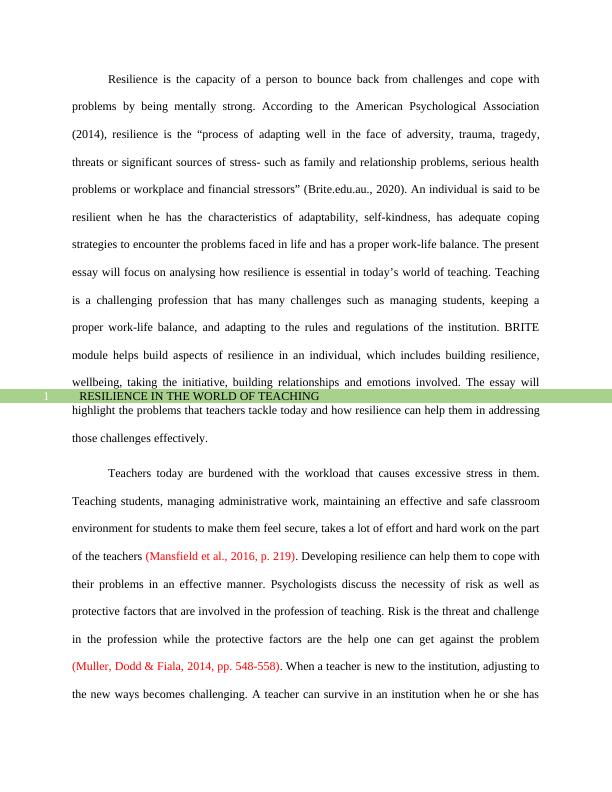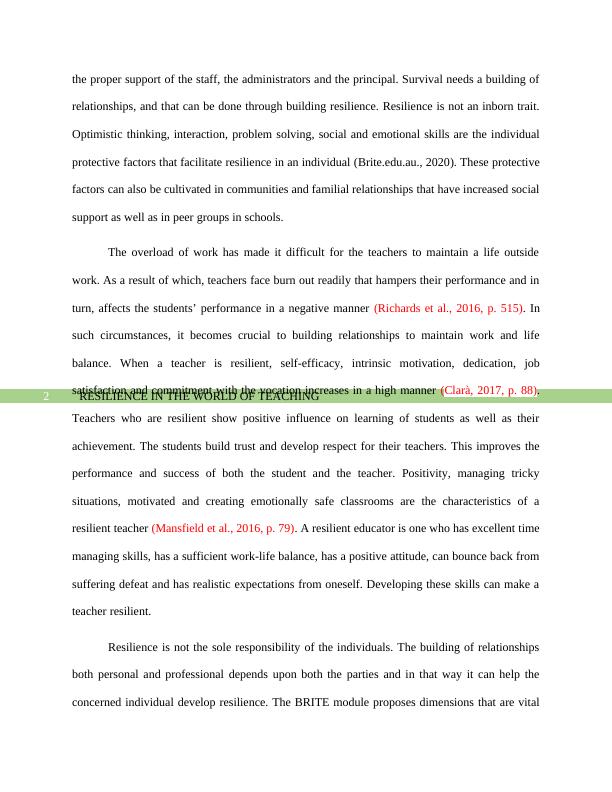Resilience in the World of Teaching
Added on 2022-07-29
6 Pages1500 Words35 Views
Running head: RESILIENCE IN THE WORLD OF TEACHING
RESILIENCE IN THE WORLD OF TEACHING
Name of the Student
Name of the University
Author note
RESILIENCE IN THE WORLD OF TEACHING
Name of the Student
Name of the University
Author note

RESILIENCE IN THE WORLD OF TEACHING1
Resilience is the capacity of a person to bounce back from challenges and cope with
problems by being mentally strong. According to the American Psychological Association
(2014), resilience is the “process of adapting well in the face of adversity, trauma, tragedy,
threats or significant sources of stress- such as family and relationship problems, serious health
problems or workplace and financial stressors” (Brite.edu.au., 2020). An individual is said to be
resilient when he has the characteristics of adaptability, self-kindness, has adequate coping
strategies to encounter the problems faced in life and has a proper work-life balance. The present
essay will focus on analysing how resilience is essential in today’s world of teaching. Teaching
is a challenging profession that has many challenges such as managing students, keeping a
proper work-life balance, and adapting to the rules and regulations of the institution. BRITE
module helps build aspects of resilience in an individual, which includes building resilience,
wellbeing, taking the initiative, building relationships and emotions involved. The essay will
highlight the problems that teachers tackle today and how resilience can help them in addressing
those challenges effectively.
Teachers today are burdened with the workload that causes excessive stress in them.
Teaching students, managing administrative work, maintaining an effective and safe classroom
environment for students to make them feel secure, takes a lot of effort and hard work on the part
of the teachers (Mansfield et al., 2016, p. 219). Developing resilience can help them to cope with
their problems in an effective manner. Psychologists discuss the necessity of risk as well as
protective factors that are involved in the profession of teaching. Risk is the threat and challenge
in the profession while the protective factors are the help one can get against the problem
(Muller, Dodd & Fiala, 2014, pp. 548-558). When a teacher is new to the institution, adjusting to
the new ways becomes challenging. A teacher can survive in an institution when he or she has
Resilience is the capacity of a person to bounce back from challenges and cope with
problems by being mentally strong. According to the American Psychological Association
(2014), resilience is the “process of adapting well in the face of adversity, trauma, tragedy,
threats or significant sources of stress- such as family and relationship problems, serious health
problems or workplace and financial stressors” (Brite.edu.au., 2020). An individual is said to be
resilient when he has the characteristics of adaptability, self-kindness, has adequate coping
strategies to encounter the problems faced in life and has a proper work-life balance. The present
essay will focus on analysing how resilience is essential in today’s world of teaching. Teaching
is a challenging profession that has many challenges such as managing students, keeping a
proper work-life balance, and adapting to the rules and regulations of the institution. BRITE
module helps build aspects of resilience in an individual, which includes building resilience,
wellbeing, taking the initiative, building relationships and emotions involved. The essay will
highlight the problems that teachers tackle today and how resilience can help them in addressing
those challenges effectively.
Teachers today are burdened with the workload that causes excessive stress in them.
Teaching students, managing administrative work, maintaining an effective and safe classroom
environment for students to make them feel secure, takes a lot of effort and hard work on the part
of the teachers (Mansfield et al., 2016, p. 219). Developing resilience can help them to cope with
their problems in an effective manner. Psychologists discuss the necessity of risk as well as
protective factors that are involved in the profession of teaching. Risk is the threat and challenge
in the profession while the protective factors are the help one can get against the problem
(Muller, Dodd & Fiala, 2014, pp. 548-558). When a teacher is new to the institution, adjusting to
the new ways becomes challenging. A teacher can survive in an institution when he or she has

RESILIENCE IN THE WORLD OF TEACHING2
the proper support of the staff, the administrators and the principal. Survival needs a building of
relationships, and that can be done through building resilience. Resilience is not an inborn trait.
Optimistic thinking, interaction, problem solving, social and emotional skills are the individual
protective factors that facilitate resilience in an individual (Brite.edu.au., 2020). These protective
factors can also be cultivated in communities and familial relationships that have increased social
support as well as in peer groups in schools.
The overload of work has made it difficult for the teachers to maintain a life outside
work. As a result of which, teachers face burn out readily that hampers their performance and in
turn, affects the students’ performance in a negative manner (Richards et al., 2016, p. 515). In
such circumstances, it becomes crucial to building relationships to maintain work and life
balance. When a teacher is resilient, self-efficacy, intrinsic motivation, dedication, job
satisfaction and commitment with the vocation increases in a high manner (Clarà, 2017, p. 88).
Teachers who are resilient show positive influence on learning of students as well as their
achievement. The students build trust and develop respect for their teachers. This improves the
performance and success of both the student and the teacher. Positivity, managing tricky
situations, motivated and creating emotionally safe classrooms are the characteristics of a
resilient teacher (Mansfield et al., 2016, p. 79). A resilient educator is one who has excellent time
managing skills, has a sufficient work-life balance, has a positive attitude, can bounce back from
suffering defeat and has realistic expectations from oneself. Developing these skills can make a
teacher resilient.
Resilience is not the sole responsibility of the individuals. The building of relationships
both personal and professional depends upon both the parties and in that way it can help the
concerned individual develop resilience. The BRITE module proposes dimensions that are vital
the proper support of the staff, the administrators and the principal. Survival needs a building of
relationships, and that can be done through building resilience. Resilience is not an inborn trait.
Optimistic thinking, interaction, problem solving, social and emotional skills are the individual
protective factors that facilitate resilience in an individual (Brite.edu.au., 2020). These protective
factors can also be cultivated in communities and familial relationships that have increased social
support as well as in peer groups in schools.
The overload of work has made it difficult for the teachers to maintain a life outside
work. As a result of which, teachers face burn out readily that hampers their performance and in
turn, affects the students’ performance in a negative manner (Richards et al., 2016, p. 515). In
such circumstances, it becomes crucial to building relationships to maintain work and life
balance. When a teacher is resilient, self-efficacy, intrinsic motivation, dedication, job
satisfaction and commitment with the vocation increases in a high manner (Clarà, 2017, p. 88).
Teachers who are resilient show positive influence on learning of students as well as their
achievement. The students build trust and develop respect for their teachers. This improves the
performance and success of both the student and the teacher. Positivity, managing tricky
situations, motivated and creating emotionally safe classrooms are the characteristics of a
resilient teacher (Mansfield et al., 2016, p. 79). A resilient educator is one who has excellent time
managing skills, has a sufficient work-life balance, has a positive attitude, can bounce back from
suffering defeat and has realistic expectations from oneself. Developing these skills can make a
teacher resilient.
Resilience is not the sole responsibility of the individuals. The building of relationships
both personal and professional depends upon both the parties and in that way it can help the
concerned individual develop resilience. The BRITE module proposes dimensions that are vital

End of preview
Want to access all the pages? Upload your documents or become a member.
Related Documents
Challenges Faced by Teachers and Building Resiliencelg...
|6
|1248
|25
Developing Teacher Identitylg...
|6
|1230
|51
Performance Psychology - Challenges by Low Status Studentslg...
|4
|743
|13
Resilience and Wellbeing in Healthcarelg...
|28
|6558
|50
Building Professional Capacity: Mentoring for Graduate Registered Nurseslg...
|10
|2351
|414
How Resilience Works Project Report 2022lg...
|6
|1886
|20
